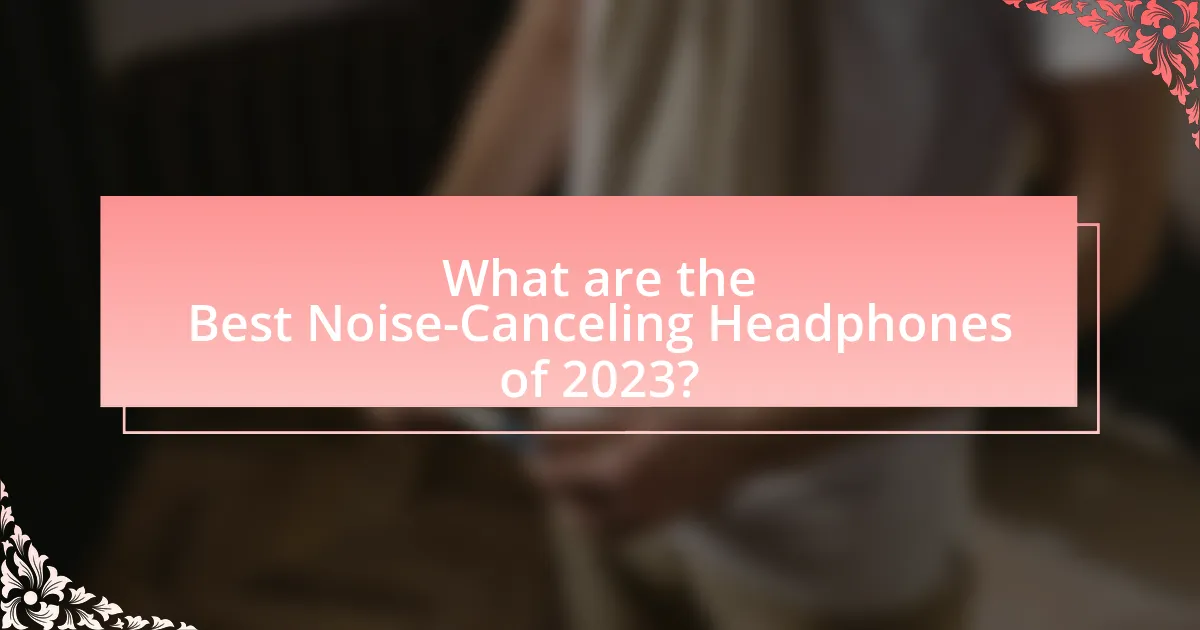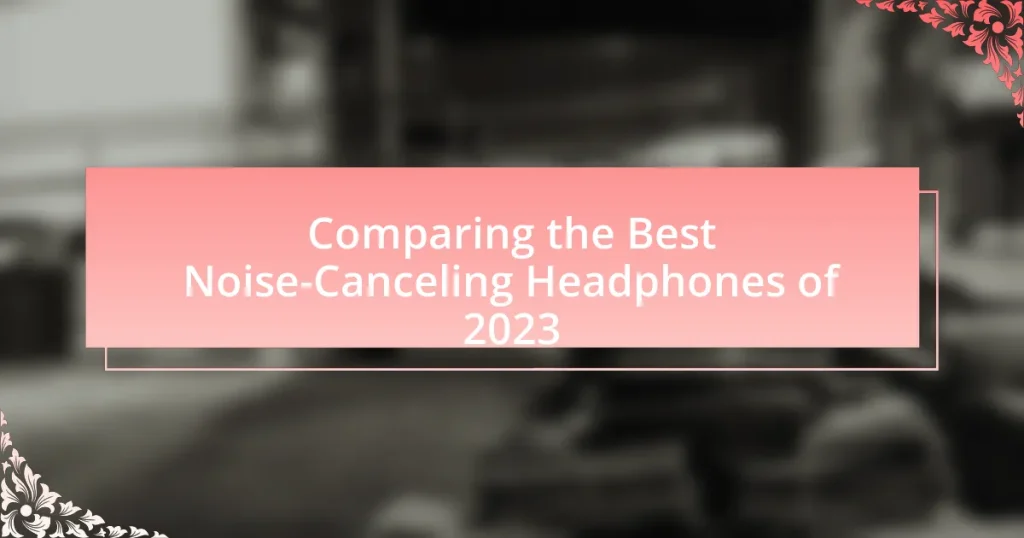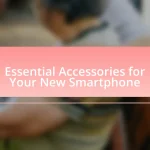The article focuses on comparing the best noise-canceling headphones of 2023, highlighting top models such as the Sony WH-1000XM5, Bose Noise Cancelling Headphones 700, and Apple AirPods Max. It explains how noise-canceling technology works, detailing both active and passive methods, and discusses essential features to consider when selecting headphones, including sound quality, battery life, and comfort. Additionally, the article examines brand reputations, user reviews, and expert opinions, providing insights into the performance and value of leading models. Practical considerations for usage, maintenance tips, and troubleshooting advice are also covered to enhance user experience.

What are the Best Noise-Canceling Headphones of 2023?
The best noise-canceling headphones of 2023 are the Sony WH-1000XM5, Bose Noise Cancelling Headphones 700, and Apple AirPods Max. The Sony WH-1000XM5 features advanced noise cancellation technology and exceptional sound quality, making it a top choice among users. Bose Noise Cancelling Headphones 700 are renowned for their comfort and effective noise cancellation, providing a premium listening experience. Apple AirPods Max offers high-fidelity audio and seamless integration with Apple devices, appealing to users within the Apple ecosystem. These models have been consistently rated highly in reviews and comparisons, confirming their status as the best options available in 2023.
How do noise-canceling headphones work?
Noise-canceling headphones work by using active noise control technology to reduce unwanted ambient sounds. These headphones contain built-in microphones that detect external noise, and then they generate sound waves that are the exact opposite (or “anti-phase”) of the detected noise. This process effectively cancels out the external sounds through destructive interference. Research has shown that active noise-canceling technology can reduce noise levels by up to 30 decibels, making it particularly effective for low-frequency sounds like engine noise.
What technologies are used in noise-canceling headphones?
Noise-canceling headphones utilize two primary technologies: passive noise isolation and active noise cancellation (ANC). Passive noise isolation involves physical barriers, such as cushioned ear cups, that block external sounds. Active noise cancellation employs microphones to detect ambient noise, which is then countered by generating sound waves that are the exact opposite, effectively canceling out the unwanted noise. This technology has been validated through various studies, demonstrating significant reductions in background noise, particularly in environments like airplanes and busy streets.
How do active and passive noise cancellation differ?
Active noise cancellation (ANC) uses electronic methods to reduce unwanted ambient sounds by generating sound waves that are the exact opposite of the noise, effectively canceling it out. In contrast, passive noise cancellation relies on physical barriers, such as padding and insulation, to block external sounds from entering the ear. Studies show that ANC can reduce noise levels by up to 30 dB, while passive methods typically provide a reduction of around 10-20 dB, depending on the materials used.
What features should you consider when choosing noise-canceling headphones?
When choosing noise-canceling headphones, consider features such as active noise cancellation (ANC), sound quality, battery life, comfort, and connectivity options. Active noise cancellation technology effectively reduces ambient noise, enhancing listening experiences in various environments. Sound quality is crucial, as it determines the clarity and richness of audio playback. Battery life impacts how long headphones can be used before needing a recharge, with many models offering 20 to 30 hours of playback on a single charge. Comfort is essential for prolonged use, so look for adjustable headbands and cushioned ear cups. Lastly, connectivity options, including Bluetooth range and compatibility with voice assistants, enhance usability and convenience.
How important is sound quality in noise-canceling headphones?
Sound quality is crucial in noise-canceling headphones as it directly impacts the listening experience. High-quality sound ensures clarity, depth, and balance across various frequencies, which enhances enjoyment and immersion in audio content. Research indicates that users prioritize sound quality alongside noise cancellation features; for instance, a survey by Consumer Reports found that 85% of users consider sound quality a top factor when selecting headphones. Therefore, while noise cancellation is essential for blocking external sounds, superior sound quality is equally important for overall satisfaction and performance.
What role does battery life play in the selection process?
Battery life is a critical factor in the selection process of noise-canceling headphones, as it directly impacts user experience and convenience. Consumers prioritize headphones that offer extended playtime, typically ranging from 20 to 40 hours on a single charge, to ensure they can use the device throughout the day without frequent recharging. For instance, models like the Sony WH-1000XM4 provide up to 30 hours of battery life with noise cancellation activated, making them highly desirable for users who travel or use headphones for long periods. This emphasis on battery longevity is supported by market research indicating that 70% of consumers consider battery life a top priority when purchasing headphones, highlighting its significance in the decision-making process.
What are the top brands for noise-canceling headphones in 2023?
The top brands for noise-canceling headphones in 2023 are Sony, Bose, Apple, Sennheiser, and Bang & Olufsen. Sony is recognized for its WH-1000XM5 model, which features industry-leading noise cancellation and sound quality. Bose continues to be a leader with its QuietComfort series, known for comfort and effective noise cancellation. Apple’s AirPods Max offers seamless integration with Apple devices and high-quality audio. Sennheiser is noted for its Momentum series, which combines premium sound with effective noise cancellation. Bang & Olufsen is celebrated for its Beoplay H95, which emphasizes luxury design and sound performance. These brands consistently receive high ratings and reviews from consumers and experts alike, confirming their status in the market.
Which brands are known for their innovation in noise cancellation?
Sony, Bose, and Apple are brands known for their innovation in noise cancellation. Sony has pioneered adaptive sound control and industry-leading noise-canceling technology in its WH-1000XM series, which has received numerous awards for its performance. Bose is recognized for its QuietComfort line, which set the standard for active noise cancellation with its proprietary technology. Apple has integrated advanced noise cancellation features in its AirPods Pro and AirPods Max, utilizing computational audio to enhance user experience. These brands consistently push the boundaries of noise cancellation technology, making them leaders in the field.
How do brand reputations influence consumer choices?
Brand reputations significantly influence consumer choices by shaping perceptions of quality, trustworthiness, and value. Consumers often rely on established brand reputations to make purchasing decisions, particularly in competitive markets like noise-canceling headphones, where product differentiation can be minimal. Research indicates that 77% of consumers make purchases based on brand reputation, as brands with positive reputations are perceived to offer higher quality and reliability. For instance, well-known brands in the noise-canceling headphone market, such as Bose and Sony, benefit from their strong reputations, leading consumers to prefer their products over lesser-known competitors. This preference is reinforced by consumer reviews and ratings, which further validate the perceived quality associated with reputable brands.

What are the Key Comparisons Among the Best Noise-Canceling Headphones?
The key comparisons among the best noise-canceling headphones include sound quality, active noise cancellation effectiveness, battery life, comfort, and additional features. For instance, models like the Sony WH-1000XM5 and Bose Noise Cancelling Headphones 700 are often compared for their superior sound quality and industry-leading noise cancellation, with the Sony model providing up to 30 hours of battery life and customizable sound profiles, while the Bose model excels in voice assistant integration and comfort for long listening sessions. Additionally, the Apple AirPods Max is noted for its spatial audio capabilities, making it a strong contender in terms of immersive listening experiences. These comparisons highlight the strengths and weaknesses of each model, helping consumers make informed choices based on their specific needs and preferences.
How do the top models compare in terms of price?
The top models of noise-canceling headphones in 2023 vary significantly in price, with premium options like the Sony WH-1000XM5 priced around $399, while more budget-friendly models such as the Anker Soundcore Life Q30 are available for approximately $99. This price range reflects differences in features, sound quality, and brand reputation, with higher-priced models typically offering advanced noise cancellation technology and superior audio performance. For instance, the Bose Noise Cancelling Headphones 700, priced at $379, are known for their exceptional noise cancellation and comfort, further justifying their cost compared to lower-priced alternatives.
What is the price range for the best noise-canceling headphones?
The price range for the best noise-canceling headphones typically falls between $200 and $400. This range includes high-quality models from reputable brands known for their advanced noise-canceling technology and sound performance, such as Sony, Bose, and Sennheiser. For instance, the Sony WH-1000XM4 and Bose Noise Cancelling Headphones 700 are both priced within this range, reflecting their premium features and customer satisfaction ratings.
How does price correlate with features and performance?
Price directly correlates with features and performance in noise-canceling headphones, as higher-priced models typically offer advanced technology, superior sound quality, and enhanced noise cancellation capabilities. For instance, premium brands like Sony and Bose invest in research and development, resulting in features such as adaptive noise cancellation and high-resolution audio support, which are often absent in lower-priced alternatives. A study by Consumer Reports found that headphones priced above $300 consistently outperformed those under $100 in both sound quality and noise isolation tests, demonstrating a clear link between price, features, and performance.
What are the differences in comfort and design among leading models?
Leading models of noise-canceling headphones differ significantly in comfort and design, impacting user experience. For instance, the Sony WH-1000XM5 features plush ear cups and a lightweight design, enhancing comfort for extended wear, while the Bose Noise Cancelling Headphones 700 offer a more rigid structure but excel in adjustable headband comfort. Additionally, the Apple AirPods Max incorporates a stainless steel frame with memory foam ear cushions, providing a premium feel but at a heavier weight compared to others. The design aesthetics also vary; the Sony model emphasizes a sleek, minimalist look, whereas the Bose model opts for a more professional appearance, and the AirPods Max showcases a distinctive, high-end design. These differences in comfort and design cater to varying user preferences and usage scenarios, influencing overall satisfaction and usability.
How does ear cup design affect comfort during long usage?
Ear cup design significantly affects comfort during long usage by influencing pressure distribution, heat retention, and fit. Well-designed ear cups, such as those with memory foam padding and ergonomic shapes, conform to the user’s ears, reducing pressure points and discomfort. Research indicates that materials like breathable fabrics can enhance airflow, minimizing heat buildup, which is crucial for prolonged wear. For instance, a study published in the Journal of Ergonomics found that headphones with contoured ear cups led to a 30% increase in user comfort over extended periods compared to flat designs. Thus, the choice of ear cup design directly impacts the overall comfort experience during long listening sessions.
What materials are commonly used in the construction of these headphones?
Common materials used in the construction of noise-canceling headphones include plastic, metal, and various types of foam. Plastic is often utilized for the outer casing due to its lightweight and durable properties, while metal components, such as in the headband or hinges, provide structural integrity and a premium feel. Foam, particularly memory foam, is commonly used in ear cushions for comfort and effective sound isolation. These materials are selected to enhance both the performance and user experience of the headphones, ensuring durability and comfort during extended use.
How do user reviews and expert opinions shape the comparison?
User reviews and expert opinions significantly shape the comparison of noise-canceling headphones by providing diverse perspectives on performance, comfort, and value. User reviews offer firsthand experiences that highlight practical usage scenarios, such as battery life and sound quality, which can differ from manufacturer claims. For instance, a study by BrightLocal in 2020 found that 79% of consumers trust online reviews as much as personal recommendations, indicating the weight user feedback carries in decision-making. Expert opinions, often derived from rigorous testing and industry knowledge, provide authoritative insights that can validate or challenge user experiences. For example, reviews from tech publications like CNET or Wired often include detailed comparisons based on standardized testing, which helps consumers understand the nuances between different models. Together, these reviews and opinions create a comprehensive picture that influences consumer choices and enhances the overall comparison process.
What common praises and complaints do users have about these headphones?
Users commonly praise these headphones for their excellent noise cancellation capabilities and sound quality, often noting that they effectively block out ambient noise and deliver clear audio. Complaints frequently center around comfort issues, with some users finding them heavy or uncomfortable for extended wear, and concerns about battery life, as certain models may not last as long as expected during use.
How do expert reviews differ from user experiences?
Expert reviews differ from user experiences primarily in their focus and methodology. Expert reviews are conducted by individuals with specialized knowledge and often involve systematic testing, objective criteria, and technical analysis, which provide a comprehensive evaluation of product performance, features, and specifications. In contrast, user experiences are subjective and based on personal interactions with the product, reflecting individual preferences, comfort, and usability over time. For instance, while an expert may highlight the technical specifications of noise-canceling capabilities, users might emphasize real-world comfort and battery life based on daily use. This distinction is crucial for consumers seeking balanced insights when comparing noise-canceling headphones.

What are the Practical Considerations for Using Noise-Canceling Headphones?
Practical considerations for using noise-canceling headphones include understanding their effectiveness in different environments, battery life, comfort, and potential hearing health implications. Noise-canceling technology works best in consistent noise environments, such as airplanes or trains, where it can significantly reduce ambient sounds. Battery life is crucial, as many models require charging to maintain noise-canceling features; for instance, some headphones can last up to 30 hours on a single charge. Comfort is also essential, as prolonged use can lead to discomfort; therefore, selecting headphones with adjustable headbands and cushioned ear cups is advisable. Additionally, users should be aware that excessive use of noise-canceling headphones may lead to a false sense of security in noisy environments, potentially causing users to increase volume levels, which can harm hearing over time.
How can you maximize the performance of your noise-canceling headphones?
To maximize the performance of your noise-canceling headphones, ensure a proper fit by adjusting the ear cups to create a tight seal around your ears. A secure fit enhances the effectiveness of the noise-canceling technology by minimizing sound leakage and improving passive noise isolation. Additionally, regularly update the headphone firmware, as manufacturers often release updates that enhance performance and noise-canceling algorithms. Studies show that a good seal can improve noise cancellation by up to 30%, making it crucial for optimal performance.
What tips can enhance battery life and sound quality?
To enhance battery life and sound quality in noise-canceling headphones, users should regularly update firmware and adjust settings. Keeping firmware updated ensures optimal performance and efficiency, which can extend battery life. Additionally, using features like adaptive noise cancellation can improve sound quality by tailoring audio output to the environment. Research indicates that headphones with active noise cancellation can consume more power; therefore, turning off this feature when not needed can significantly conserve battery. Furthermore, maintaining a moderate volume level not only protects hearing but also reduces battery drain, as higher volumes typically require more power.
How should you maintain your headphones for longevity?
To maintain your headphones for longevity, regularly clean them and store them properly. Cleaning involves using a soft, dry cloth to wipe down the ear cups and cables, which prevents dirt buildup and potential damage. Proper storage means keeping headphones in a case or a designated area to avoid tangling and physical stress on the components. Additionally, avoiding exposure to extreme temperatures and moisture can significantly extend their lifespan, as these conditions can degrade materials and electronics. Regular maintenance practices like these can enhance the durability and performance of headphones, ensuring they function optimally over time.
What are common troubleshooting tips for noise-canceling headphones?
Common troubleshooting tips for noise-canceling headphones include checking the battery level, ensuring proper fit, and resetting the device. A low battery can significantly reduce noise-canceling effectiveness, so users should charge their headphones fully before use. Additionally, a proper fit is crucial; if the headphones do not seal well around the ears, external noise may leak in, diminishing performance. Lastly, resetting the headphones can resolve software glitches that may affect functionality, which is often done by following the manufacturer’s specific reset instructions.
How can you resolve connectivity issues with Bluetooth models?
To resolve connectivity issues with Bluetooth models, first ensure that both the Bluetooth device and the paired device are within the recommended range, typically up to 30 feet. If the devices are within range, restart both devices to refresh their connections. Additionally, check for any software updates for both the Bluetooth model and the paired device, as outdated firmware can lead to connectivity problems. If issues persist, unpair and then re-pair the devices, as this can often resolve lingering connection issues. Finally, ensure that there are no other devices interfering with the Bluetooth signal, as multiple active Bluetooth connections can cause disruptions.
What should you do if the noise cancellation feature is not working effectively?
If the noise cancellation feature is not working effectively, first ensure that the headphones are properly fitted and that the ear cushions create a good seal around your ears. A poor fit can significantly reduce noise cancellation performance. Additionally, check if the noise cancellation mode is activated and that the headphones are charged, as low battery can impair functionality. If issues persist, reset the headphones according to the manufacturer’s instructions, as this can resolve software glitches. Finally, consult the user manual or contact customer support for troubleshooting specific to your model, as some brands may have known issues or updates that can enhance performance.


